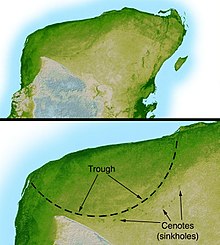At the peak of the Mesozoic, there were no polar ice caps, and sea levels are estimated to have been from 100 to 250 meters (300 to 800 ft) higher than they are today. The planet's temperature was also much more uniform, with only 25 °C (45 °F) separating average polar temperatures from those at the equator. On average, atmospheric temperatures were also much higher; the poles, for example, were 50 °C (90 °F) warmer than today.
The atmosphere's composition during the Mesozoic was vastly different as well. Carbon dioxide levels were up to 12 times higher than today's levels, and oxygen formed 32 to 35% of the atmosphere, as compared to 21% today. However, by the late Cretaceous, the environment was changing dramatically. Volcanic activity was decreasing, which led to a cooling trend as levels of atmospheric carbon dioxide dropped. Oxygen levels in the atmosphere also started to fluctuate and would ultimately fall considerably. Some scientists hypothesize that climate change, combined with lower oxygen levels, might have led directly to the demise of many species. If the dinosaurs had respiratory systems similar to those commonly found in modern birds, it may have been particularly difficult for them to cope with reduced respiratory efficiency, given the enormous oxygen demands of their very large bodies.
Impact event

The Chicxulub Crater at the tip of the Yucatán Peninsula; the impactor that formed this crater may have caused the dinosaur extinction.
Although the speed of extinction cannot be deduced from the fossil record alone, various models suggest that the extinction was extremely rapid. The consensus among scientists who support this theory is that the impact caused extinctions both directly (by heat from the meteorite impact) and also indirectly (via a worldwide cooling brought about when matter ejected from the impact crater reflected thermal radiation from the sun).
In September 2007, U.S. researchers led by William Bottke of the Southwest Research Institute in Boulder, Colorado, and Czech scientists used computer simulations to identify the probable source of the Chicxulub impact. They calculated a 90% probability that a giant asteroid named Baptistina, approximately 160 km (100 mi) in diameter, orbiting in the asteroid belt which lies between Mars and Jupiter, was struck by a smaller unnamed asteroid about 55 km (35 mi) in diameter about 160 million years ago. The impact shattered Baptistina, creating a cluster which still exists today as the Baptistina family. Calculations indicate that some of the fragments were sent hurtling into earth-crossing orbits, one of which was the 10 km (6 mi) wide meteorite which struck Mexico's Yucatan peninsula 65 million years ago, creating the Chicxulub crater.
A similar but more controversial explanation proposes that "passages of the [hypothetical] solar companion star Nemesis through the Oort comet cloud would trigger comet showers." One or more of these comets then collided with the Earth at approximately the same time, causing the worldwide extinction. As with the impact of a single asteroid, the end result of this comet bombardment would have been a sudden drop in global temperatures, followed by a protracted cool period.
Deccan Traps
Before 2000, arguments that the Deccan Traps flood basalts caused the extinction were usually linked to the view that the extinction was gradual, as the flood basalt events were thought to have started around 68 million years ago and lasted for over 2 million years. However, there is evidence that two-thirds of the Deccan Traps were created in only 1 million years about 65.5 million years ago, and so these eruptions would have caused a fairly rapid extinction, possibly over a period of thousands of years, but still longer than would be expected from a single impact event.The Deccan Traps could have caused extinction through several mechanisms, including the release into the air of dust and sulphuric aerosols, which might have blocked sunlight and thereby reduced photosynthesis in plants. In addition, Deccan Trap volcanism might have resulted in carbon dioxide emissions, which would have increased the greenhouse effect when the dust and aerosols cleared from the atmosphere. Before the mass extinction of the dinosaurs, the release of volcanic gases during the formation of the Deccan Traps "contributed to an apparently massive global warming. Some data point to an average rise in temperature of 8 °C (14 °F) in the last half million years before the impact [at Chicxulub]."
In the years when the Deccan Traps theory was linked to a slower extinction, Luis Alvarez (who died in 1988) replied that paleontologists were being misled by sparse data. While his assertion was not initially well-received, later intensive field studies of fossil beds lent weight to his claim. Eventually, most paleontologists began to accept the idea that the mass extinctions at the end of the Cretaceous were largely or at least partly due to a massive Earth impact. However, even Walter Alvarez has acknowledged that there were other major changes on Earth even before the impact, such as a drop in sea level and massive volcanic eruptions that produced the Indian Deccan Traps, and these may have contributed to the extinctions.
0 comments:
Post a Comment